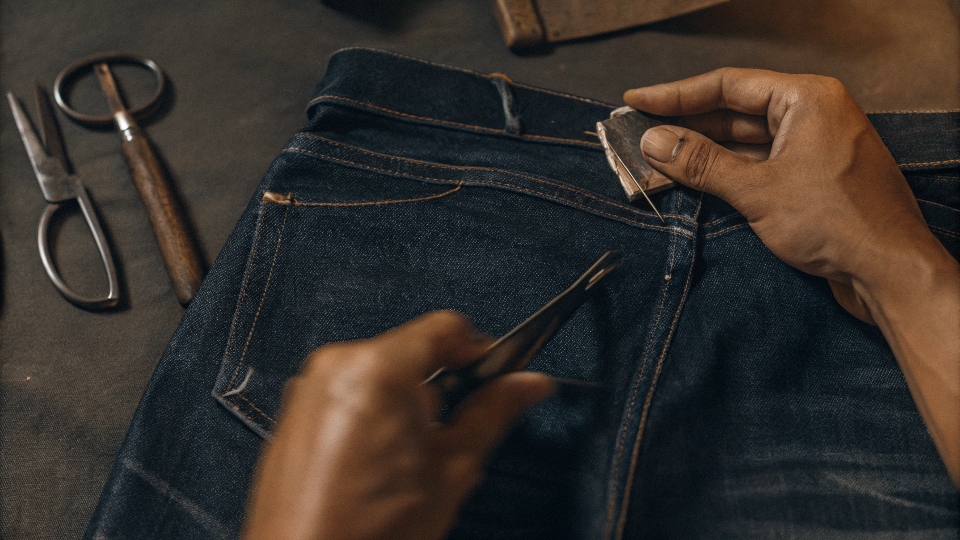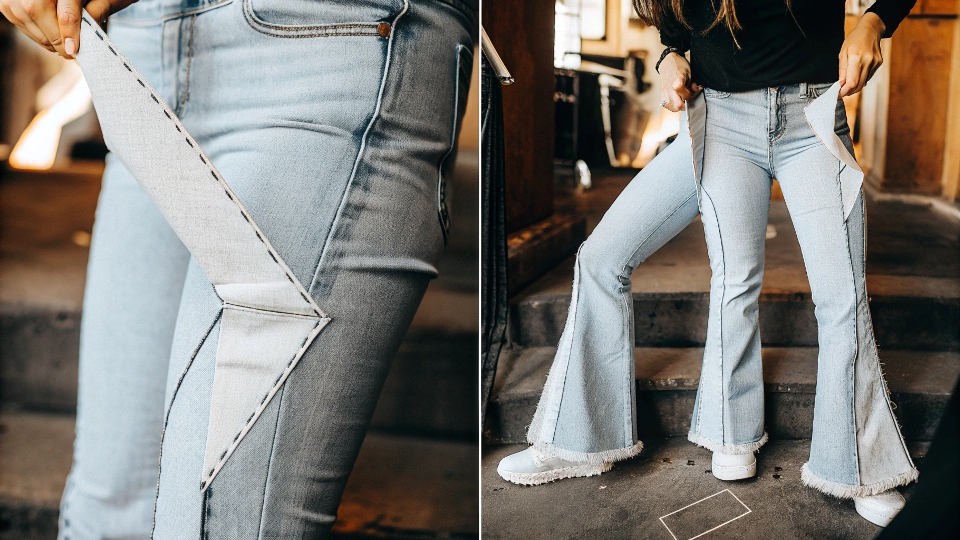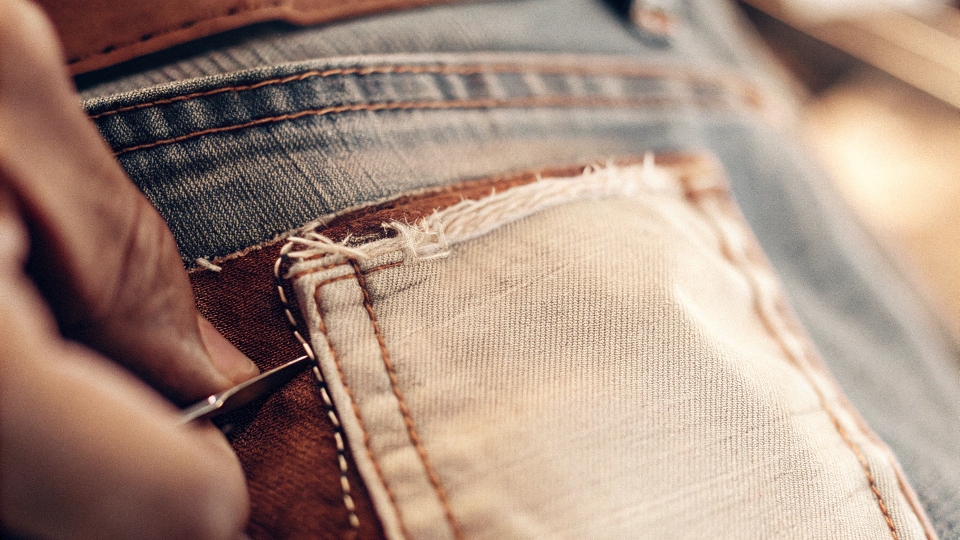You see stylish ripped jeans in every store, but the prices are high. You'd love to try it yourself, but you are afraid one bad cut will completely ruin your favorite pair.
Yes, you can absolutely make holes in your jeans at home. With a few simple tools and a careful plan, you can create a customized, distressed look that looks intentional and stylish, not accidental.
In my factory, we call this "distressing," and we have a whole range of techniques to make jeans look worn-in, from sandblasting to laser finishing.
Designers like Dean often ask for a very specific level of destruction—a small tear here, a soft fray there.
While our methods are industrial, the goal is the same: to make the damage look natural and authentic. You can achieve that same authentic look at home.
The secret is to start small and build up the effect gradually. It's about taking away fabric, and you can't put it back once it's gone.
How to create holes in jeans?
You want to give your jeans that cool, ripped look. But you have no idea where to start and worry you'll just end up with a messy, ugly tear.
To create natural-looking holes1, first mark the spot with chalk. Then, make a small horizontal cut with sharp scissors, and use sandpaper and tweezers2 to fray the edges and pull out threads.
The key to good distressing is to mimic how jeans would wear out naturally over time.
In the factory, we study vintage pairs to understand this. Knees, thighs, and back pockets are the most common spots.
To do it yourself, start by putting the jeans on and marking where you want the hole with chalk. Take them off and lay them flat on a hard surface.
Put a piece of cardboard inside the leg so you don't cut through to the other side. Use sharp scissors or a box cutter to make a small horizontal slit.
Don't cut a big square; that never looks right. After you make the cut, the real work begins. Rub the edges with sandpaper to soften them up.
Then, use tweezers to pull out the vertical blue threads (the warp), leaving the horizontal white threads (the weft) behind. This creates that classic frayed, stringy look you see in store-bought jeans.
What do Gen Z wear instead of skinny jeans?
You know skinny jeans aren't the top trend anymore. You see younger people in different styles and wonder how the new fits work with DIY projects like distressing.
Gen Z overwhelmingly prefers looser denim fits3 over skinny jeans. The most popular styles are baggy, straight-leg, wide-leg, and cargo jeans, which are all perfect canvases for DIY distressing.
This shift to looser fits has been huge for the denim industry. At my factory, the production orders have completely changed from high-stretch skinny styles to more rigid, 100% cotton in relaxed silhouettes.
This trend is perfect for anyone who loves to customize their clothes. Looser-fitting jeans are actually much easier to distress than tight skinny jeans.
When you cut a hole in a tight jean, the fabric is already under tension, and the hole can easily stretch out and become too big.
With baggy or straight-leg jeans, the fabric hangs loosely, so a hole or a frayed patch will keep its shape much better.
This trend is also driven by thrift culture and sustainability, so taking an old, loose pair of jeans and giving them new life by adding some personalized holes fits the aesthetic perfectly. It's all about comfort and individual expression.
Can you make skinny jeans into flares?
You have a pair of skinny jeans that you don't wear much anymore. With flares making a comeback, you wonder if you can transform your old jeans into a new style.
Yes, you can make skinny jeans into flares, but it is an advanced sewing project. It involves cutting the outer seam and sewing in a triangular panel of fabric4 to create the flare.
This is a really cool upcycling project that completely changes the silhouette of the jeans. In the factory, a flare jean is cut from a pattern piece that is shaped like a bell from the knee down.
To replicate this at home, you need to add fabric. The process involves slitting the outer seam of each leg, from the hem up to the knee.
Then, you cut a triangular piece of denim—this is called a "godet"—and sew it into that opening. The wider the base of your triangle, the bigger the flare will be.
It's best to use denim from an old pair of jeans you no longer need, so the color and weight of the fabric match.
This requires careful measuring, pinning, and precise sewing with a strong needle meant for denim5. While it’s a challenge, the result is a truly custom pair of flares that you made yourself.
Can you sew holes in jeans?
You either bought ripped jeans and the holes are now too big, or you have a pair with a tear you don't like. You want to fix them but aren't sure how.
Yes, you can easily sew holes in jeans. The two best methods are applying a patch from behind for a reinforced, visible mend or using a darning stitch6 to rebuild the fabric.
Repairing denim is a skill that adds so much character to a garment. Both methods give a different look. Patching is very popular right now, especially as part of the "visible mending7" trend.
To do this, you take a piece of sturdy fabric (it can be more denim or a fun patterned cloth) and place it on the inside of the jeans, behind the hole.
Then you secure it with stitches that are visible from the outside. You can do simple lines or creative patterns like the Japanese Sashiko style.
Darning is a more traditional repair. This is best for smaller holes or areas where the fabric is just thinning out.
It involves sewing a tight grid of stitches back and forth over the hole, essentially creating a new patch made entirely of thread.
This blends in a bit more than a patch but still provides a strong, durable repair that extends the life of your favorite jeans.
Conclusion
Making or mending holes in your jeans is a simple and creative way to personalize them. With a few tools, you can update your denim and give old pairs new life.
-
Learn the step-by-step process to create stylish, natural-looking holes in your jeans. ↩
-
Discover the tools and techniques for achieving a distressed look using sandpaper and tweezers. ↩
-
Discover the latest denim trends favored by Gen Z and how to style them. ↩
-
Learn the sewing techniques needed to insert a triangular panel and create flared jeans. ↩
-
Find out which needle works best for sewing denim to ensure your projects are successful. ↩
-
Understand the darning stitch method for a durable and seamless repair on your jeans. ↩
-
Explore the art of visible mending to add character and style to your jeans. ↩


[^3]](https://diznewjeans.com/wp-content/uploads/2025/10/to-create-natural-looking-holes-first-mark-the-.jpg)








